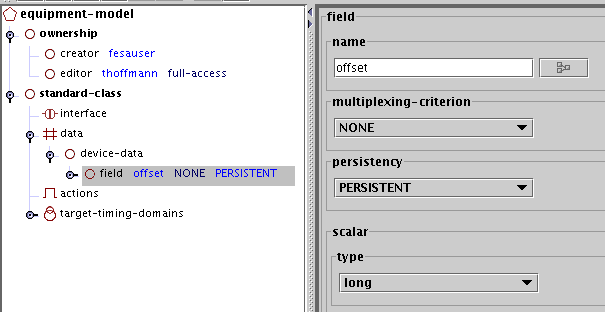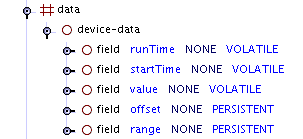You are here: Foswiki>FESA Web>HowTo>StepByStep>StepByStepDesign1 (18 Mar 2009, HaraldBraeuning)Edit Attach
-- HaraldBraeuning - 18 Mar 2009
 Because the 'offset' is a settable parameter of our class, we make it PERSISTENT. This has two effects: First we can define an initial value later on, when we create an instance of the class. Second, the value is stored when the running class is terminated. In contrast, data which changes frequently like acuired data or the random value our class will calculate should be given the persistency VOLATILE. Immutable data fields, like for example VME addresses, should be given the FINAL persitency.
Because the 'offset' is a settable parameter of our class, we make it PERSISTENT. This has two effects: First we can define an initial value later on, when we create an instance of the class. Second, the value is stored when the running class is terminated. In contrast, data which changes frequently like acuired data or the random value our class will calculate should be given the persistency VOLATILE. Immutable data fields, like for example VME addresses, should be given the FINAL persitency.
 The image above shows the 5 data fields required for our class. The fields 'offset' and 'range' are adjustable settings of our class and are persistent. The field 'value' is randomly calculated from the 'offset' and 'range' settings everytime acquired data is requested from the class. It is thus volatile. The fields 'runTime' and 'startTime' are required to return the status of the Fesa class. 'startTime' will hold the unix time when the class was started on the FEC or when the last reset of the class was issued. 'runTime' will hold the current running time in seconds since 'startTime'. Both fields are of course volatile.
The image above shows the 5 data fields required for our class. The fields 'offset' and 'range' are adjustable settings of our class and are persistent. The field 'value' is randomly calculated from the 'offset' and 'range' settings everytime acquired data is requested from the class. It is thus volatile. The fields 'runTime' and 'startTime' are required to return the status of the Fesa class. 'startTime' will hold the unix time when the class was started on the FEC or when the last reset of the class was issued. 'runTime' will hold the current running time in seconds since 'startTime'. Both fields are of course volatile.
Designing the Fesa Class
Creating the data fields
The next step is to add the required data fields to the design. The data fields reflect all data associated with the class. They also reflect internal data, which is not communicated to the outside like hardware registers etc. To add a data field, select device-data and right-click to open the popup menu. From the popup menu select Add / field to add a standard data field and fill in the required data. The image shows the properties for the 'offset' parameter. Because the 'offset' is a settable parameter of our class, we make it PERSISTENT. This has two effects: First we can define an initial value later on, when we create an instance of the class. Second, the value is stored when the running class is terminated. In contrast, data which changes frequently like acuired data or the random value our class will calculate should be given the persistency VOLATILE. Immutable data fields, like for example VME addresses, should be given the FINAL persitency.
Because the 'offset' is a settable parameter of our class, we make it PERSISTENT. This has two effects: First we can define an initial value later on, when we create an instance of the class. Second, the value is stored when the running class is terminated. In contrast, data which changes frequently like acuired data or the random value our class will calculate should be given the persistency VOLATILE. Immutable data fields, like for example VME addresses, should be given the FINAL persitency.
 The image above shows the 5 data fields required for our class. The fields 'offset' and 'range' are adjustable settings of our class and are persistent. The field 'value' is randomly calculated from the 'offset' and 'range' settings everytime acquired data is requested from the class. It is thus volatile. The fields 'runTime' and 'startTime' are required to return the status of the Fesa class. 'startTime' will hold the unix time when the class was started on the FEC or when the last reset of the class was issued. 'runTime' will hold the current running time in seconds since 'startTime'. Both fields are of course volatile.
The image above shows the 5 data fields required for our class. The fields 'offset' and 'range' are adjustable settings of our class and are persistent. The field 'value' is randomly calculated from the 'offset' and 'range' settings everytime acquired data is requested from the class. It is thus volatile. The fields 'runTime' and 'startTime' are required to return the status of the Fesa class. 'startTime' will hold the unix time when the class was started on the FEC or when the last reset of the class was issued. 'runTime' will hold the current running time in seconds since 'startTime'. Both fields are of course volatile.
| I | Attachment | Action | Size | Date | Who | Comment |
|---|---|---|---|---|---|---|
| |
StepByStep4.png | manage | 8 K | 18 Mar 2009 - 14:52 | HaraldBraeuning | Creating the data fields |
| |
StepByStep5.png | manage | 2 K | 18 Mar 2009 - 14:59 | HaraldBraeuning | The data fields of the class |
Edit | Attach | Print version | History: r1 | Backlinks | View wiki text | Edit wiki text | More topic actions
Topic revision: r1 - 18 Mar 2009, HaraldBraeuning
 Copyright © by the contributing authors. All material on this collaboration platform is the property of the contributing authors.
Copyright © by the contributing authors. All material on this collaboration platform is the property of the contributing authors. Ideas, requests, problems regarding Foswiki? Send feedback


